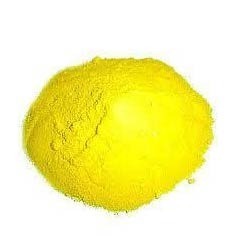
Sodium Chromate

Sodium Chromate can be prepared from chromite (Fe(CrO2)2) ore by treating sodium carbonate.
Sodium chromate is hygroscopic. It absorbs moisture in air to give tetrahydrate. It is easily dissolves in water to give yellow chromate ions.
Addition of a dilute acid will shift the above equation to the right and the solution turns from yellow to orange. However, addition of an alkaline solution will shift the equation to the left, turning the solution from orange to yellow. Between two extremes it is possible for both chromate and dichromate ions to coexist in proportion according to the value of the pH.
Despite the fact that the oxidation state of chromium in both chromate and dichromate is +6, sodium chromate is not as strong oxidizing agent as the dichromate. However, the former can be used to precipitate metal chromates (in alkaline solution)
The red-brown silver(I) chromate can be dissolved in strongly ionized acids such as sulfuric and nitric acids but are insoluble in those which are feebly ionized such as ethanoic acid (CH3COOH)
History and Uses
Sodium chromate is used in the industry as an important source for manufacture of chromium compounds. It is used in certain types of corrosion control applications such as coolants containing alcohols and water cooling systems by forming a protective film on metal surfaces.
Other applications include pigment formulation, mordant for dyeing wool, wood preservative, oil well drilling fluids and catalysts.
By making use of Cr-51 isotope with a half life of 27.8 days, sterile sodium chromate(VI) solution is used in pharmaceuticals for the determination of circulatory red cell volume, cell survival time and evaluation of blood lose.
Hazard, Storage and Handling
The compound should be kept in air tight container away from all organic compounds and any incompatible substances. Do not store on wooden floors.
May be carcinogenic. Harmful by ingestion and skin adsorption. It may cause irritation and burning sensation to skins and eyes. The dust may ulcerate mucous membranes. Symptoms may also include coughing, sneezing, diarrhea, dizziness, shock and liver damage. Decomposes upon heating to give toxic chromium oxides fumes.
In case of skin contact, splash with plenty of water. Gently wash all affected skin areas with soap and water. In case of eye contact splash eye with plenty of water. Upon ingestion, do not induce vomiting. If the victim is conscious, administer plenty of water to dilute the chemical and seek medical attention. Seek immediate medical attention in all cases.
Wear protective clothing and safety goggles in a well ventilated area when handling the chemical.